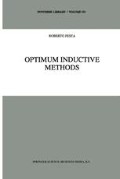Abstract
In this chapter the so-called de Finetti’s representation theorem (DFRT) is used to elucidate some conceptual relationships between TIP and the analysis of multinomial inferences in BS.
Access this chapter
Tax calculation will be finalised at checkout
Purchases are for personal use only
Preview
Unable to display preview. Download preview PDF.
Notes
De Finetti (1937, pp. 124–129) proved his representation theorem for the case where k = 2. Subsequently, DFRT has been generalized to k > 2 (cf. Good, 1965, pp. 21–23).
Cf. Hintikka (1971, pp. 329–336).
Cf. Gaifman (1971, § 3) and Fine (1973, p. 194). See also Jeffrey’s Editor’s Note to Carnap (1980, § 20, p. 120 ).
De Finetti conceived his representation theorem as a tool to get rid of unknown objective probabilities and, accordingly, considered probability distributions on unknown objective probabilities as “mere mathematical fictions” (Hintikka, 1971, p. 333).
It may also be assumed that, in certain cases, X believes that the ‘multivariate Bernoulli model’ provides a convenient approximation to (idealization of) the real ‘structure’ of the multicategorical process Ex in examination.
For the ‘convergence towards the truth’ of predictive probabilities see Hintikka (1971, pp. 336–339). See also Niiniluoto (1980, pp. 433–434 and p. 454, note 34).
Author information
Authors and Affiliations
Rights and permissions
Copyright information
© 1993 Springer Science+Business Media Dordrecht
About this chapter
Cite this chapter
Festa, R. (1993). Exchangeable Inductive Methods, Bayesian Statistics, and Convergence Towards the Truth. In: Optimum Inductive Methods. Synthese Library, vol 232. Springer, Dordrecht. https://doi.org/10.1007/978-94-015-8131-8_5
Download citation
DOI: https://doi.org/10.1007/978-94-015-8131-8_5
Publisher Name: Springer, Dordrecht
Print ISBN: 978-90-481-4318-4
Online ISBN: 978-94-015-8131-8
eBook Packages: Springer Book Archive

